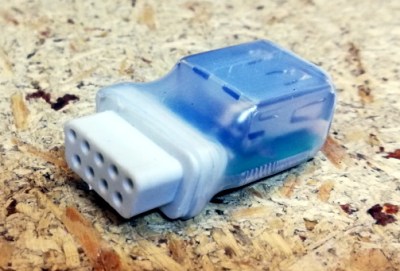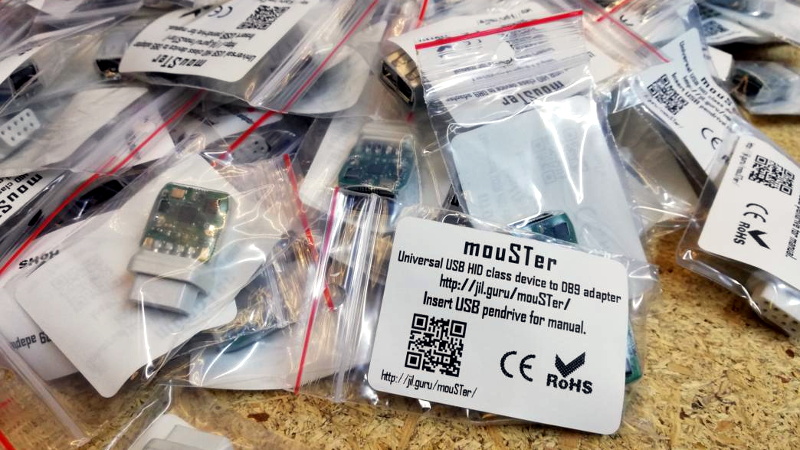Folks who like the take the old Amiga out for the occasional Sunday drive usually do it because they have wistful memories of the simpler times. Back when you could edit documents or view spreadsheets on a machine that had RAM measured in kilobytes instead of gigabytes. But even the most ardent retro computer aficionado usually allows for a bit of modern convenience.
Enter the mouSTer. This tiny device converts a common USB HID mouse into something older computers can understand. It even supports using Sony’s PlayStation 4 controller as a generic game pad. While the firmware is still getting tweaked, the team has confirmed its working on several classic machines and believe it should work on many more. Considering the prices that some of these old peripherals command on the second hand market, using a USB mouse or controller on your vintage computer isn’t just more convenient, but will likely be a lot cheaper.
 Confirmed retrocomputing superfan [Drygol] is a member of the team working on mouSTer, and in a recent post to his retrohax blog, he talks a bit about what’s happened since his last update over the summer. He also talks a bit about the challenges they’ve faced to get it into production. Even if you’re not into poking around on vintage computers, there are lessons to be learned here about what it takes to move from a handful of prototypes to something you can actually sell to the public.
Confirmed retrocomputing superfan [Drygol] is a member of the team working on mouSTer, and in a recent post to his retrohax blog, he talks a bit about what’s happened since his last update over the summer. He also talks a bit about the challenges they’ve faced to get it into production. Even if you’re not into poking around on vintage computers, there are lessons to be learned here about what it takes to move from a handful of prototypes to something you can actually sell to the public.
We especially liked the details about the mouSTer enclosure, or lack thereof. Originally [Drygol] says they were going to have the cases injection molded, but despite initial interest from a few companies they talked to, nobody ended up biting because it needed to be done with relatively uncommon low pressure injection. While 3D printing is still an option, the team ended up using clear heatshrink tubing to create a simple conformal protective shell over the electronics. Personally we think it looks great like this, but it sounds like this is only a temporary solution until something a bit more robust can be implemented.
As you might imagine we’ve seen DIY projects that aimed to bring modern input devices to vintage computers like the Atari ST, but the diminutive proportions of the mouSTer and the fact that it’s a turn-key product is sure to appeal to those who want to minimize headaches when working with their classic gear.
















Where are people sourcing these flangeless DB9 connectors? Last guy I asked said he had to invest a significant chunk of change into getting a company to produce a run of custom cables.
I’m sure you can do it with resin printers :)
I think they are custom made.
This manf may help you: http://www.spo2sale.com/
Here’s what I do for genMDM (https://catskullelectronics.com/products/genmdm)
I take a regular panel mount D-SUB 9 connector like this: https://www.taydaelectronics.com/d-sub-connector-9-pins-female.html
And de-flange it. I’ve found it works best to drill out the ring on one side, then pry it open like a clam. The actual plastic is in two pieces and without the flange will pull apart, so I separate the two halves and put some gel super glue inside. Seems to work fairly well even if a little labor intensive. I too would love to be able to buy actual DE9 ports. I know they are still in production in some form since there are lots of options for Sega controllers of all quality levels. So far I haven’t been able to find a seller for just the connector. I’d even take a cable with a JST connector on the other side but I haven’t been able to find that either!
I used to do the same for making DB23 for my Amiga out of DB25. Removing the extra pins for the male connector or cutting the plastic for the female part. I then trim the tin plated shell and try to solder them back together.
Sometimes the shielding is easily removable. Otherwise you can be a bit more destructive and still have the moulded and pinned centre
Probably Aliexpress or eBay. Couple years ago I scored a 100 of those flangeless DB9 connectors as NOS off of eBay. Sadly I lost them in the mess of parts in my Shop.
Does it autosense comms params (baud, parity, flowcontrol, data and stop bits)? Will 2 or more function simultaneously on a computer? On a hub? Can they function as serial console monitors?
These aren’t serial, they’re for Atari-style joysticks or raw quadrature mouse signals.
shutupandtakemymoney.jpg
I’ve said it before and I’ll say it again but shut up and take my money!
“using a USB mouse or controller on your vintage computer isn’t just more convenient, but will likely be a lot cheaper”
Unlikely, considering the mouSTer retail price of $32.
Why even comment without checking? The cheapest Atari ST mouse I can find on ebay is $50 right now.
Awwww… though I remember when a Mouse Systems Mouse and ISA interface card was like $250 1980s dollars.
Tempts me more to do my own thing, vs getting a 5 pack for $60 or something if they were cheaper.
I have a suspicion that a lot of mouse entrails still have PS/2 functionality so get them to speak that by default (Swap a resistor??) and then it’s just a bit of fudgery to make it sprechen Amiga.
When a PS/2 capable USB mouse sees both the Data+ and Data – lines pulled high, it switches to PS/2 protocol. This particular state is not used in the USB standard – It is either D+ or D- pulled high by the device. At other time, it likely bit-bang the USB 1.0. Chances are that USB mouse that runs at full speed (i.e. hardware USB) don’t fall back to PS/2.
Amiga mouse is actually the raw signals from the X and Y quadrature encoder and mouse buttons. You’ll need a microcontroller to decode PS/2. It is still a heck simplier than having to have a USB stack.
Thanks, I thought I was remembering an easy hack off Aminet for it, but yeah, using PICs etc. in all those… there was something in my head about just switching some lines and adding a pullup or something, maybe that was master system game pads.
The easiest hack is finding a mouse with an OMO2 optical encoder chip that’s separate from the protocol encoder, these can be modified by cutting traces and soldering a suitable cable directly to the pins of the chip, and maybe altering how the mouse buttons are wired (pull-up or pull-down resistors). I’ve done this to make optical mice for Amiga and Acorn machines.
I think the main problem is that most recent mice seem to use an all-in-one chip that doesn’t expose the quadrature signals on its pins.
BTW same thing for PS/2 capable USB keyboards. Keyboards tends to have their pull ups too while mice relies on the host side.
Hmm. Looks like this would be a really interesting DIY project as well if you have something like a due with USB host mode. There’s already a library for mice, so it’s just a matter of figuring out the protocol for the older mouse.
But this is a nice finished product; I love the tiny build and the fact that you can upgrade the firmware with a USB drive a great usability feature. It sure beats the expensive PS/2 adaptors they used to sell.
I need to go the other way. I have some nice ps2 keyboards that I want to use with modern computers.
Sounds like a fun weekend project for a blue pill board. They can easily appear as a USB/HID device and you would just need to convert the protocol between the two. I did something similar with some tiny ALPS trackballs I bought surplus *years* ago. They speak Microsoft serial mouse protocol. My code just read from the serial port and converted the received packets to HID events. Worked pretty well and finally let me complete a project I’ve been wanting to do for over a decade.
These are the trackballs I used: https://digilander.libero.it/adrianodm/tb/tinytrackball.htm
Not my web site.
I found a writeup of how the Microsoft serial mouse protocol worked: https://linux.die.net/man/4/mouse
Took the stock HID/mouse example code and ripped out the guts and replaced it with a little routine to do protocol conversion.
At some point I’ll design and print a case for it. I’ll probably have to add buttons at that point, which I can do by hooking them either to the mouse (which has a few button inputs) and let my code convert them or wire them to the bluepill directly and let it generate the HID events directly.
Ok , dumb question..
Anything inexpensive that does this in reverse?
My wife desperately wants to play pitfall, and I’d like to hook up an Atari joystick via usb to my Mac. Any ideas?
See my comment to EdK above. You should easily be able to do something like that with a blue pill board. It can appear as a USB/HID joystick and you can read the five switch closures from the Atari joystick and convert them to HID events. Should be <50 lines of code with the standard libraries.
Something like this? https://www.retrousb.com/product_info.php?cPath=21&products_id=70&osCsid=f20eafffc76e7729b40d09d331ae963a
There’s a few different ones out there, I bought the RetroFun! ones but I can’t find a link to them right now.
Morse code on the status LED is cool, as is the neat config/debug onto a USB flash drive. Nice work.
There is also a cheaper true USB adapter for the Amiga and ST, even works with my Logitech MX Master wireless mouse, called TruMouse